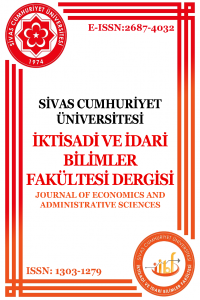Abstract
Bu çalışma, 90’lı yılların
ortalarından itibaren montaj temelli çalışan işletmelere uygulanmaya başlanan
yeni bir üretim sistemi olan seru sistemini tanıtmaktadır. Uluslararası
literatürde çok fazla yaygın olmayan bir konu olan seru, ulusal literatüre de ilk
kez bu çalışma ile girmektedir. Çalışmada seru üretim sisteminin doğuşu,
anlamı, türleri, yararları ve matematiksel modellemesi tanımlanmaktadır. Geleneksel
montaj hattının sökülüp nasıl seru sistemine dönüştürüldüğü de detaylı olarak
anlatılmıştır. Bu araştırma, hali hazırda geleneksel montaj hattını kullanan
işletmelerde uygulanabilmesi için bulundurulması gereken temel özellikleri
anlatarak, bundan sonra yapılacak uygulamalı çalışmalara da ön ayak olacağı
düşünülmektedir.
References
- FORTUNĂ, M. E., SIMION, I. M., VE GAVRILESCU, M. (2011). Indicators For Sustainability In Industrıal Systems Case Study: Paper Manufacturıng. In International Conference Of Applied Sciences, Chemistry And Chemical Engineering–Cısa, 28-30.
- ISA, K., VE TSURU, T. (2002). Cell Production And Workplace Innovation in Japan: Toward A New Model For Japanese Manufacturing? Industrial Relations: A Journal Of Economy And Society, 41(4), 548-578.
- JOHNSON, D. J. (2005). Converting Assembly Lines To Assembly Cells At Sheet Metal Products: Insights On Performance Improvements. International Journal Of Production Research, 43(7), 1483-1509.
- JONSSON, D., MEDBO, L., ve ENGSTRÖM, T. (2004). Some Considerations Relating To The Reintroduction Of Assembly Lines in The Swedish Automotive Industry. International Journal Of Operations ve Production Management, 24(8), 754-772.
- KAKU, I. (2017). Is Seru A Sustainable Manufacturing System?. Procedia Manufacturing, 8, 723-730.
- KAKU, I., GONG, J., TANG, J., VE YIN, Y. (2008). A Mathematical Model for Converting Conveyor Assembly Line to Cellular Manufacturing. Industrial Engineering ve Management Systems, 7(2), 160-170.
- KAKU, I., GONG, J., TANG, J., VE YIN, Y. (2009). Modeling And Numerical Analysis Of Line-Cell Conversion Problems. International Journal Of Production Research, 47(8), 2055-2078.
- KAKU, I., MURASE, Y., VE YIN, Y. (2008). A Study On Human-Task-Related Performances In Converting Conveyor Assembly Line To Cellular Manufacturing. European Journal Of Industrial Engineering, 2(1), 17-34.
- LIU, C., LI, W., LIAN, J., VE YIN, Y. (2012). Reconfiguration Of Assembly Systems: From Conveyor Assembly Line To Serus. Journal Of Manufacturing Systems, 31(3), 312-325.
- LIU, C., LIAN, J., YIN, Y., VE LI, W. (2010). Seru Seisan‐An Innovation Of The Production Management Mode in Japan. Asian Journal Of Technology Innovation, 18(2), 89-113.
- LIU, C., STECKE, K. E., LIAN, J., VE YIN, Y. (2014). An Implementation Framework For Seru Production. International Transactions in Operational Research, 21(1), 1-19.
- LIU, C., YANG, N., LI, W., LIAN, J., EVANS, S., VE YIN, Y. (2013). Training And Assignment Of Multi-Skilled Workers For Implementing Seru Production Systems. The International Journal Of Advanced Manufacturing Technology, 69(5-8), 937-959.
- MIYAKE, D. I. (2006). The Shift From Belt Conveyor Line To Work-Cell Based Assembly Systems To Cope With Increasing Demand Variation in Japanese Industries. International Journal Of Automotive Technology And Management, 6(4), 419-439.
- SAKAZUME, Y. (2005). Is Japanese Cell Manufacturing A New System?: A Comparative Study Between Japanese Cell Manufacturing And Cellular Manufacturing (Special English Issue Production And Logistics). Journal Of Japan Industrial Management Association, 55(6), 341-349.
- SAKAZUME, Y. (2006). Conditions For Successful Implementation Of Assembly Cells. Industrial Engineering And Management Systems, 5(2), 142-148.
- STECKE, K. E., YIN, Y., KAKU, I., VE MURASE, Y. (2012). Seru: The Organizational Extension Of Jıt For A Super-Talent Factory. International Journal Of Strategic Decision Sciences (Ijsds), 3(1), 106-119.
- SUN, W., LI, Q., HUO, C., YU, Y., VE MA, K. (2016). Formulations, Features Of Solution Space, And Algorithms For Line-Pure Seru System Conversion. Mathematical Problems In Engineering, 2016.
- VILLA, A., VE TAURINO, T. (2013). From Jıt To Seru, For A Production As Lean As Possible. Procedia Engineering, 63, 956-965.
- WU, L., CHAN, F. T., NIU, B., VE LI, L. (2018). Cross-Trained Worker Assignment And Comparative Analysis On Throughput Of Divisional And Rotating Seru. Industrial Management ve Data Systems, 118(5), 1114-1136.
- YIN, Y., KAKU, I., VE STECKE, K. E. (2008). The Evolution Of Seru Production Systems Throughout Canon. Neilsonjournals Publishing.
- YIN, Y., KAKU, I., MURASE, Y., VE YASUDA, K. (2006). Converting Flow Lines To Manufacturing Cells Another Revolution? Cellular Manufacturing Implementations in Japan. In Proceedings Of The Third Int. Conf. On Group Technology/Cellular Manufacturing-Gt/Cm, Groningen, Netherlands, July, 94–104.
- YING, K. C., VE TSAI, Y. J. (2017). Minimising Total Cost For Training And Assigning Multiskilled Workers in Seru Production Systems. International Journal Of Production Research, 55(10), 2978-2989.
- YU, Y., SUN, W., TANG, J., VE WANG, J. (2017). Line-Hybrid Seru System Conversion: Models, Complexities, Properties, Solutions And Insights. Computers ve Industrial Engineering, 103, 282-299.
- YU, Y., TANG, J., GONG, J., YIN, Y., VE KAKU, I. (2014). Mathematical Analysis and Solutions For Multi-Objective Line-Cell Conversion Problem. European Journal Of Operational Research, 236(2), 774-786.
- YU, Y., WANG, J., MA, K., VE SUN, W. (2018). Seru System Balancing: Definition, Formulation, And Exact Solution. Computers and Industrial Engineering, 122, 318-325.
- YU, Y., WANG, S., TANG, J., KAKU, I., VE SUN, W. (2016). Complexity Of Line-Seru Conversion For Different Scheduling Rules and Two Improved Exact Algorithms for The Multi-Objective Optimization. Springerplus, 5(1), 809.
- ZWIERZYŃSKI, P., VE AHMAD, H. (2018). Seru Production As An Alternative to A Traditional Assembly Line. Engineering Management in Production And Services, 10(3), 62-69.
Details
| Primary Language | Turkish |
|---|---|
| Subjects | Business Administration |
| Journal Section | Makaleler |
| Authors | |
| Publication Date | November 23, 2020 |
| Submission Date | September 8, 2019 |
| Published in Issue | Year 2020 Volume: 21 Issue: 2 |
Cited By
Profitability analysis with the fuzzy logic: A hospital example
Corporate Governance and Organizational Behavior Review
https://doi.org/10.22495/cgobrv5i2p2
Seru üretim sisteminde hat-seru dönüşümü ve çizelgeleme problemi için matematiksel model önerisi
Gazi Üniversitesi Mühendislik Mimarlık Fakültesi Dergisi
https://doi.org/10.17341/gazimmfd.884293
Geleneksel Montaj Üretim Sisteminin Hat-Seru Modeline Dönüştürülmesi: Çikolata Üretiminde Seru Üretim Sistemi
Eskişehir Osmangazi Üniversitesi Sosyal Bilimler Dergisi
https://doi.org/10.17494/ogusbd.1303118
Cumhuriyet University Journal of Economics and Administrative Sciences is licensed under a Creative Commons Attribution-NonCommercial 4.0 International License (CC BY NC).

